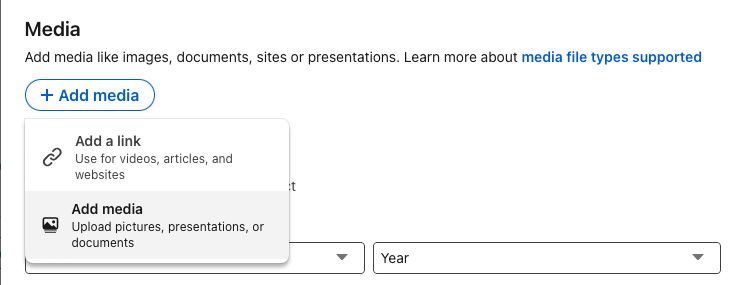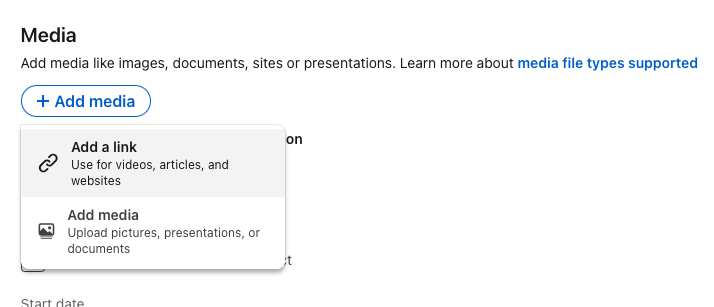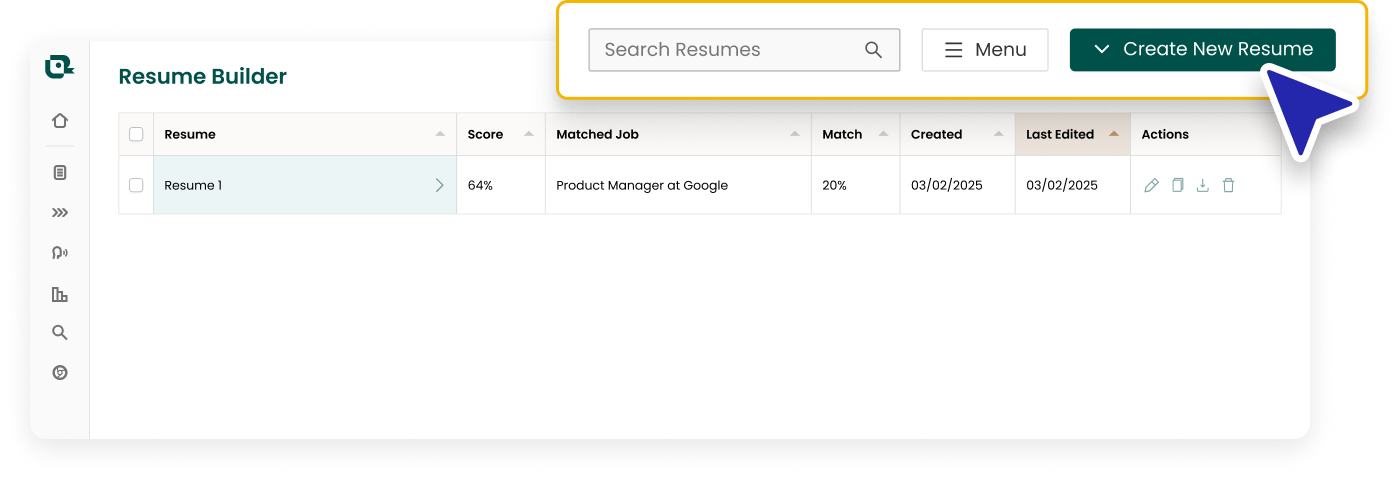3 key takeaways
- LinkedIn profile pages include a dedicated Projects section plus additional ways to showcase work projects.
- Adding projects to your LinkedIn profile helps attract potential employers.
- Teal’s AI Resume Builder helps you create a customizable resume from your LinkedIn profile in a matter of minutes.
Projects make up the foundation of a portfolio while elevating your LinkedIn profile and resume.
If you’re applying to project-heavy roles, you’ll want to share relevant projects. Not applying to project-heavy roles? You’ll still want to highlight projects to demonstrate your creativity, effectiveness, collaboration, and initiative.
This guide shares multiple ways to effectively showcase a project on your LinkedIn profile.
Want to create a resume from your LinkedIn in seconds? Get started with Teal’s AI Resume Builder today.
How to add projects to LinkedIn
Here’s the step-by-step process to add projects to your LinkedIn profile. Below, you’ll find more detailed guidance for adding specific items to your project, including project name, date range, images, and links.
- Log into your LinkedIn account.
- Go to your LinkedIn profile.
- In your Introduction section, click “Add profile section.”
- Click from the “Recommended” drop-down list.
- Choose "Add projects".

- Fill in the project details:
- Project Name
- Description
- Skills (up to five)
- Media
- Timeline
- Contributors
- Associated with (from Experience)
- Click Save.
Adding Projects to LinkedIn gives you the option to add several details to the project. Details are optional, but beneficial to include—especially project name, project dates, and rich media features. This helps potential employers understand your role in the project, the steps involved to complete it, and a visual overview of the end result.
Arguably the most important step to adding projects to LinkedIn is adding images, so you can begin there.
How to add images to projects in LinkedIn
- Follow steps one through five of “How to add Projects to LinkedIn.”
- Under project details, click “Add media.”
- Choose “Add media” to upload pictures, presentations, or documents.

You’ll be prompted to choose pictures, presentations, or documents from your computer.
- Add a title. This will be the title of the media item, not the project name.
- Add a description (optional).
- Complete the rest of your project information and click “Save.”
How to add a project URL on LinkedIn
- Follow steps one through five of “How to add Projects to LinkedIn.”
- Under project details, click “Add media.”
- Choose “Add a link” to upload videos, articles, and websites.

- Paste or type a link to an article, file, or video.
- Select “Add.”
- Add a title. This will be the title of the link, not the project title.
- Add a description. (Optional)
- Complete the rest of your project information.
- Save.
Other places to add URLs to LinkedIn
You can also add live project and portfolio URLs to your:
- Contact info
- Introduction section
- Projects under Experience
Adding links to your LinkedIn projects is a great way to showcase your work. To learn more, check out this in-depth blog on adding links in your resume.
How to feature a project on LinkedIn
Adding a project to the Featured section is a great way to boost your proud portfolio to the top of your LinkedIn profile.
If you’ve recently added a project to the Projects section of LinkedIn, you’ll see this post prompt:
- When prompted, click “Start a post.”

- LinkedIn will auto-populate text for a LinkedIn post. You can leave it as is or create your own post.
- Click “Post.”
- When viewing your post, go to the F at the top right corner.
- Click the three dots, then choose the starred option “Feature on top of profile.”
.png)
How to add Github projects to LinkedIn
Have a treasure trove of code you want to show off on your LinkedIn page? You can add your Github projects one of two ways: updating the Contact area or editing the About section.To your Contact section
- In your Contact section, click the Pencil icon.
- Scroll down to Contact info. Click "Edit contact info."
- Within the Website field, add the Github portfolio link.

- Optionally, you can choose to label it as your portfolio. See the example below.

Adding Github to your About section
Your About section is a plain-text section of your profile where you can tell viewers about yourself, your experience, work philosophy, and more. It’s also a great spot to add links to your profiles. Take advantage of this space to add your Github link.

Boost your job search efforts by completing your About section with a short description about your current job, job titles, expertise, about yourself, and portfolio and project links.
- Go to your profile.
- Scroll down to your About section.
- Click the pencil icon to edit.
- Write your description and add your Github portfolio.
Troubleshooting links and projects on LinkedIn
Why you can't add a project URL in LinkedIn
LinkedIn has removed the Project URL button. Never fear! There’s still a way. To add a link to the Projects section, click “Add media,” then select “Add a link.”
Why your URL looks different than the one you added
When you share a link longer than 26 characters, LinkedIn will automatically shorten it once you post.
Why do you see an error when sharing a URL
Make sure you haven’t shared a URL with spaces in them. Those will result in an error.
How to add projects to a LinkedIn resume
When it comes time to apply to jobs, your profile is an asset but you’ll also need to integrate your portfolio and project links into your resume.
LinkedIn has a “Resume Builder” feature. However, because LinkedIn is more of a social media and networking site, the LinkedIn resume builder is more of an add-on feature, missing key features.
Teal’s AI Resume Builder seamlessly integrates with LinkedIn, so you can create a tailored resume from your newly optimized LinkedIn profile. Plus, you can create multiple versions of your resume and add relevant experience to each customized resume.How to use Teal’s "LinkedIn to Resume" feature
- If you haven't yet, sign up for Teal.
- Go to the Resume Builder icon in the left panel.
- Click the "New Resume" button at the top right.
- Select "Import Resume or LinkedIn.” You'll have the option to Import your LinkedIn profile via your LinkedIn Profile URL.

How to add a projects section to your resume
It’s not good practice to add images, screenshots, documents or videos to your resume, so you’ll need to adjust how you present projects on a LinkedIn resume—or any resume for that matter.
Example resume project
Project Manager: Ecommerce Website Redesign
Directed a team in the successful redesign of a corporate website for a leading e-commerce retailer, resulting in 37% increase in website traffic and a 18% rise in conversion rates within the first month of launch.
You can use Teal’s AI resume builder to select which work experiences to include in each resume. More relevant in this case would be to add certain projects under your Work Experience section.
You could also add additional projects under the corresponding sections. Here are other ways to make sure your projects get seen on your resume.
- Rename any existing section to create a custom "Projects" section
- Add a link to your LinkedIn or website portfolio
- Create an “Awards” section and list award-winning projects
- Create an accomplishments section and highlight key initiatives
- Include a project under Education
- Include a project as Volunteer experience
For more inspiration and instruction, discover how to feature projects in your resume.
If you’re a freelancer, a creative, or the bulk of your experience lies within projects, it might be worth adding a separate "Projects" or “Portfolio” section to your resume.

Within Teal's Resume Builder, you can rename section titles to your liking, to help hiring managers and recruiters quickly identify your work samples.
Why you should add projects to your LinkedIn profile
It increases your chances of attracting opportunities
Keywords related to activities and responsibilities related to an open position help recruiters find potential candidates as they conduct searches and review LinkedIn profiles. So it’s crucial your profile has keywords geared toward the job opportunities you want.
The good news: You can incorporate keywords naturally across your LinkedIn profile. Take full advantage of the Project section by adding keywords associated with the projects when filling out the project name and description using relevant, trending industry terms to enhance your profile in search results.
It solidifies your skills and talent
By now, you know it’s best to show—rather than tell—potential employers you have the skills you say you do. The Projects section on your LinkedIn profile is evidence of your potential.
The cool thing is you can upload anything—no matter if it was conducted at your current role or not. This is your chance to showcase your best work and back-up your talent with proof.
It enhances your profile and professional image
Resumes are built for summarizing your work history and work experience. Portfolios are created to show off your creative work and projects. LinkedIn is a professional profile where you get to do both.
Filling out your profile as much as possible enhances your reputation. By having a complete, well-crafted profile, you appear more experienced and professional. It also helps tackle both the “resume or portfolio” debate with one stone.
It highlights your teamwork skills
Potential employers check out your profile not just for your work history and technical skills showcased in a particular project, but to get a feel of your soft skills as a prospective employee, too. For example, how well you work with others.
The Projects section allows you to add any teammates you collaborated with on a project, giving potential employers a birds-eye view of your teamwork capabilities. Bringing a major project from start to finish with other professionals is a great way to prove you work well with others.
What types of projects can you add on LinkedIn?
Projects are attached to a role, so you can add any project as long as it's connected to a role on your Experience section. You can also connect Projects to coworkers or colleagues, but you’ll need to be connected to the person on LinkedIn.
That said, it’s up to you to highlight your proudest moments. Just be sure they're related to your work history and job search.
From graphic design to portfolios to project management, here’s a list of projects to consider adding to your profile:
- Case Studies
- Event organization plans
- E-books
- Blog posts
- Webinars
- Outlines to classes or courses you teach
- Presentations or lectures
- Featured articles
- Newsletters
- Graphic design projects
- Blueprints
- Sales management processes
Help your work projects stand out
Projects demonstrate to employer’s your efforts, experience, teamwork abilities, and talent. Some projects can be a simple bullet in the Experience section, but many projects deserve a spotlight on your Projects section on your LinkedIn and even your resume.
With Teal, you can select or deselect which projects you want to show, instantly customizing each resume with the click of a button. Strengthen your resume with your keywords from the job you’re applying to, boosting your chances of getting in front of the employers.
Create a free resume with Teal’s AI Resume Builder to get started.
Frequently Asked Questions
How do I showcase my project on LinkedIn?
You can showcase projects on LinkedIn using the Projects section. Create a project name, project description, add project dates, and include images or links to provide proof of your work. Optionally, you can add a timeline, contributors, and skills.
How do I share my project on LinkedIn?
Once you’ve uploaded LinkedIn projects, you can opt to share it as a post when prompted.
Alternatively, you can go to your Feed, and click “Start a post.” Write a brief description, add images or the URL to your new Project, and click “Post.” Either way can help elevate your job search.
How do you feature a project on LinkedIn?
If you’ve posted your project to your Feed, you can click the three dots at the top of your post, then choose the starred option “Feature on top of profile.”
If you haven’t yet uploaded something to your Projects section, head to your Feature section. Click the “Plus” icon to get started, then choose to upload a post, link, image, article, or newsletter. Fill out the form and click “Save.”

.jpeg)








